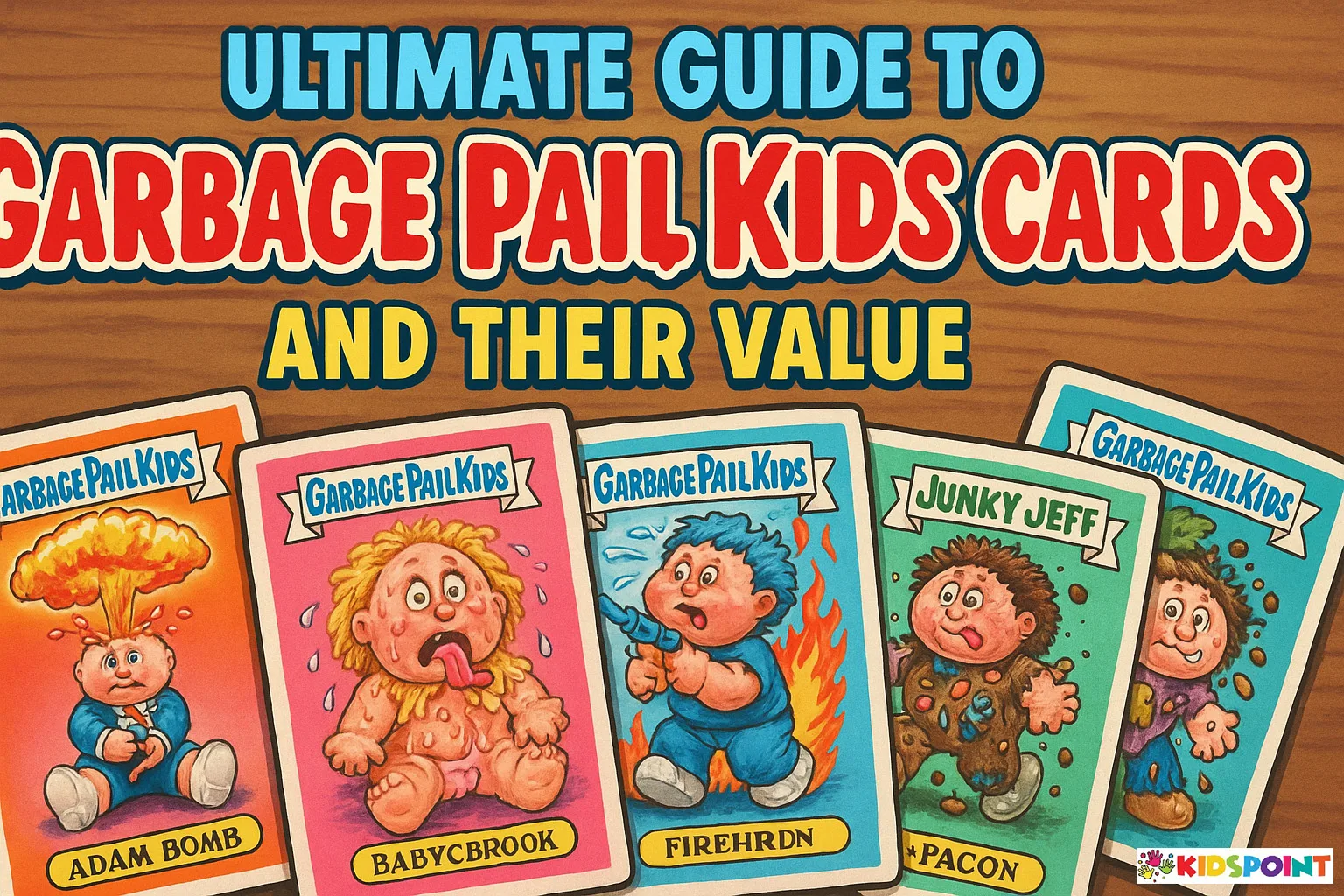Garbage Pail Kids (GPK) are one of the most bizarre yet beloved collectible trading card series in pop culture history. Known for their outrageous humor, satirical artwork, and boundary-pushing characters, these cards have fascinated collectors since their debut in 1985.
Whether you’re a nostalgic 80s kid looking to revisit childhood memories or a serious collector hunting for rare gems, understanding the history, design, rarity, and market value of Garbage Pail Kids is essential. This guide from The Kids Point covers everything you need to know — from the origins of GPK to tips for preserving and selling your cards in today’s market.
The Origin Story of Garbage Pail Kids
Garbage Pail Kids were created in 1985 by Topps, the same company famous for baseball cards and other novelty collectibles. The idea was conceived by art director Art Spiegelman (best known for his Pulitzer Prize-winning graphic novel Maus) and humorist Mark Newgarden as a parody of the wildly popular Cabbage Patch Kids dolls.
The cards were designed to be shocking, hilarious, and sometimes outright controversial. Each card featured:
- A grotesque yet comical illustration
- A pun-based name (e.g., Adam Bomb, Leaky Lindsay)
- An “A” and “B” variation with the same artwork but different names
- A peelable sticker format with a card back featuring checklists, puzzles, or jokes
When they hit the shelves, schools banned them, parents protested, and kids couldn’t get enough.
How Garbage Pail Kids Cards Are Organized
Understanding how the series is structured is key to identifying and valuing your cards.
Original Series (OS)
Topps released 15 Original Series (1985–1988) in the United States. These are the most sought-after by collectors. Each series included around 41 unique artworks, each with two name variants (A & B), totaling about 82 cards per set.
Foreign Releases
GPK cards were also released internationally, often with different names, languages, and back designs. Foreign versions from Canada, the UK, Australia, and other countries can be highly collectible.
Reissues and Modern Series
From the 2000s onward, Topps revived the GPK brand with new designs, anniversaries, and themed sets. While fun to collect, most modern cards aren’t as valuable as vintage ones — except for rare variants and autographs.
Factors That Affect Garbage Pail Kids Value
The value of a Garbage Pail Kids card depends on several key factors:
- Series & Card Number – Cards from the first few Original Series generally hold the most value.
- Character Popularity – Iconic characters like Adam Bomb are more collectible.
- Condition – Centering, corner sharpness, edges, and surface wear play a big role.
- Print Variations & Errors – Misprints, off-center cuts, and banned artworks can be more valuable.
- Grading – Professionally graded cards with high PSA or Beckett scores can command premium prices.
How to Check the Value of Your GPK Cards
If you’ve uncovered a shoebox of Garbage Pail Kids in your attic, here’s how to assess their worth:
- Identify the Series and Variation – Look for the number and letter in the corner.
- Check Condition – Mint or near-mint cards are far more valuable than worn ones.
- Research Market Prices – Check sold listings on eBay, auction houses, and collector forums.
- Consider Grading – Professional grading can boost the selling price, especially for high-demand cards.
Tips for Preserving Your Garbage Pail Kids Collection
From The Kids Point, here are best practices to keep your cards in top condition:
- Store in Acid-Free Sleeves – Prevent discoloration and bending.
- Use Top Loaders for Valuable Cards – Protect from physical damage.
- Keep in a Cool, Dry Place – Avoid moisture, sunlight, and heat.
- Handle with Clean Hands – Oils from skin can damage surfaces.
- Catalog Your Collection – Keep a digital log with photos, series numbers, and condition notes.
Where to Sell Garbage Pail Kids Cards
If you decide to sell your cards, consider:
- eBay – The largest marketplace for GPK sales.
- Specialty Auction Houses – For rare or graded cards.
- Collector Conventions – Great for networking and finding serious buyers.
- Facebook Groups & Forums – Direct sales to dedicated collectors.
The Future of Garbage Pail Kids Collecting
With nostalgia driving interest and pop culture cycles bringing retro franchises back into the spotlight, Garbage Pail Kids remain a solid collectible investment. Topps continues to release new sets, and rare vintage cards are holding — and in some cases increasing — their value.
Collectors are also starting to see crossover appeal, with digital NFT-style GPK cards entering the market. While the physical originals will always hold the most sentimental and historical value, digital collectibles are a growing niche.
Quick FAQ – Garbage Pail Kids Value
Q1: How many Original Series were made?
There were 15 Original Series released between 1985 and 1988 in the United States.
Q2: What’s the rarest GPK card?
Nasty Nick, Adam Bomb, and Schizo Fran are among the rarest and most valuable today.
Q3: How many GPK cards exist in total?
Across all variations, there are over 1,200 designs, though the most desirable are the first 15 series.
Q4: Where’s the best place to sell them?
Most collectors sell on eBay or through specialized trading card auctions.
Q5: Are modern GPK cards worth anything?
Some modern chase cards, autographs, and limited editions hold value, but vintage originals generally command higher prices.
Garbage Pail Kids are more than just cheeky 80s trading cards — they’re a quirky piece of pop culture history. Whether you’re collecting for nostalgia or investment, understanding the market and caring for your cards is the key to maximizing their value.
At The Kids Point, we believe every collector’s journey should be fun, informed, and rewarding. With the right knowledge, you might just uncover a $7,500 treasure in your collection.


